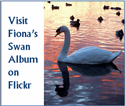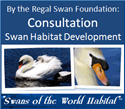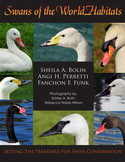Ask the Swan Specialist
Date: 30 March 2017
Hi Cheri:
This is really an in-depth question and much too long for this forum. However, we will provide you with the most salient points and then ask that you go to our website: www.swansoftheworldhabitat.com which may provide you with much more info.
First, in order to protect the swans against the predators you listed, you will need a pond completely enclosed so that the predators cannot dig under or climb into the habitat. An adequate pond size for two Australian Black Swans would be approximately 1/8 of an acre with island in the middle. You might get along with a smaller habitat as long as the water, bank and enclosure are adequate for swimming, walking and preening (see below measurements). Regardless of sodding or seeding, the swans will tear up and eat the grass, but sod may work better and then re-seed as needed. You will need some type of irrigation system on the island and around the habitat to keep the grass green and growing. Grass types do not really matter, it will just have to grow in an area with possible no shade, too much shade, and amount of water provided. You definitely should over seed in the winter using rye grass as this will provide the swans with some vegetation during the winter months as long as you do not get too hard with freezes. Also, make sure that any sod or any vegetation you use around the habitat has no fungicides, pesticides or insecticides. There are certain plants that are extremely poisonous and should not be used around the habitat. For shade, use ligustrum bushes or trees. Do not use any pine trees as the needles and the high acidity can damage the swans' feathers. You can plant petunias or choleus around the habitat and the swans will eat them. Good grazing food, again, just ensure that there are no insecticides, pesticides or fungicides on the plants or in the soil.
You can place an island in the center of a small pond/water feature around the island so that the swans can swim and it will provide adequate exercise for the birds. Think of an island surrounded by a river/moat. The pond/water feature should have not only a drain/fill feature, but also an aerator to keep the water moving. The aerator can also act as a de-icer during the winter months, just ensure that the aerator, any winches, ropes or other material cannot injure or entangle the swans.
You can use a lined or unlined pond, but the pond should be at least 4 feet deep and at least 5-6 feet wide (more than ample to allow both swans to swim side by side along the "river".
The enclosure you have poultry fencing placed under the side rails of the fence (running inside the pen) and brought up approximately 4 feet along the outside perimeter of the enclosure. This will prevent coyotes or other predators from digging under the enclosure to access the swans. The poultry fencing along the outside perimeter of the enclosure will prevent raccoons from reaching into the enclosure and possibly attacking the swans. If the swans are able to produce (male and female), they will produce 2 broods of cygnets (baby swans) every year. The swans can produce from 1-8 cygnets each brood, meaning that you may have the possibility of having 16 cygnets a year. The poultry fencing on the outside will prevent predators from reaching in the habitat to access the cygnets and will keep the cygnets in the enclosure with the parents.
The top of the enclosure should be approximately 7 feet high so that you can enter the habitat to clean without hitting your head, but the top of the enclosure must be strong enough not to collapse in on the habitat should a predator climb onto the top of the fence.
The inside of the habitat should have at least 3 feet of bank running the perimeter of the enclosure so the birds can sun bathe and rest out of the water if they are not on the island. Just because you have an island, does not necessarily mean the swans will use it, but in most instances they will especially if you place their feeder near or on the island. This will also prevent pests such as ants and rats from getting into the food supply.
You could use either a natural marsh land or filtration system. The natural marsh land may attract predators such as otters, minks, turtles, etc., unless you absolutely make sure everything is contained and nothing can get in or out of the marsh area. In the long run, a filtration system may be the best way and the most cost efficient means, but it will need to filter a lot of bacteria from poop, dirt, etc. We would suggest that you contact Vertex Water Features (www.vertexwaterfeatures.com) as they have expertise in swan habitats.
We hope that this information is of benefit. The Regal Swan
Messages In This Thread
- New Swan Habitat -- Cheri -- 29 March 2017
- Re: New Swan Habitat -- The Regal Swan -- 30 March 2017
Ask the Swan Specialist is powered by
Tetra-WebBBS 5.30 Beta © 2006-2007 Tetra-Team






